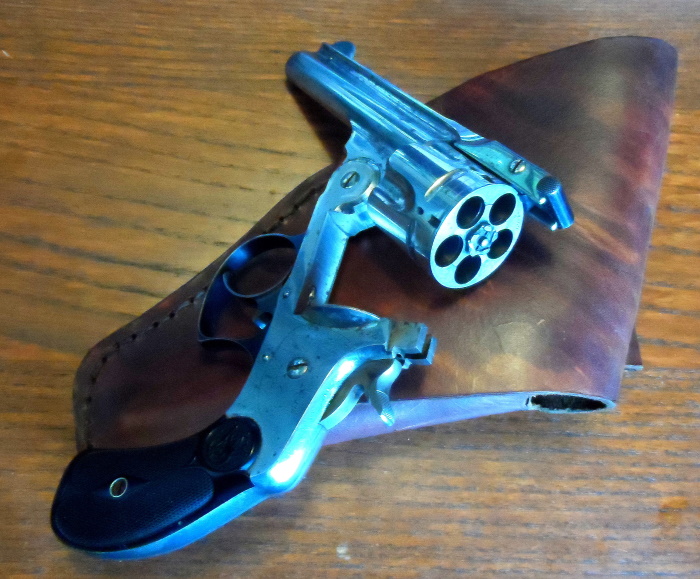Double-Action revolvers were popular in Europe, and while they were not unknown in the US they took longer to gain widespread acceptance. When Colt introduced their 1877 model S&W could not afford to be far behind. In 1880 they introduced double-action revolvers in .32 S&W and .38 S&W, and a year later they brought out their big-bore, the Double Action .44. The First Model used dual cylinder locks, one that was activated when the hammer was cocked, with a separate lock holding the cylinder after it was fired. This was later replaced by a single lock that filled both functions. .44 Russian was by far the most common chambering for these guns, but other cartridges like .38-40 were offered in smaller numbers. Barrels were available in lengths from 3-1/2″ to 8″, but most seem to have had 5-6″ barrels. An adjustable sight version was offered was well, but these are quite rare.

On a recent trip to Pinto’s Guns I found they had recently acquired a number of interesting old handguns, including two .44 Double Actions offered at quite reasonable prices. I discussed it with Linda and we determined it would not be financially suicidal to pick one up. After a hard struggle between the nicer of the Double Actions and a Model 1917 we pulled the trigger- so to speak- on the .44.
The gun is in quite good condition; there are a couple areas of minor pitting but the gun retains most of it’s original blued finish. The cylinder has a bit of side-to-side play, but not enough to be considered excessive even in a newer revolver. The double action trigger is amazing; light and smooth. If you look for stacking carefully you’ll find it, but it’s nothing you’d notice in normal use. The DA pull isn’t particularly long, either. There’s a little take-up on the single-action trigger, but it breaks clean and feels light. The original composition grips are worn but complete; I’m likely to preserve them and make a set of replacements in stag.
The gun doesn’t feel heavy in the hand, and with the 6″ barrel it balances quite nicely. I’m very much looking forward to getting it to the range!
What’s up with this ‘Russian’ stuff?
S&W’s first big-bore .44 cartridge was the .44 S&W (now called .44 S&W American.) Typical for the era it used a heel-base bullet, where the projectile and cartridge are the same diameter, with a reduced-diameter section of the bullet crimped into the cartridge (like a modern .22 Long rifle.)
Both the cartridge diameter and the bullet diameter were .440. This mean the bullet had to carry lubrication outside the case, where it could attract dust and debris. This wasn’t just messy; in extreme cases it could accumulate enough junk to make chambering the round difficult. In high heat the lubricant could melt, creating even more mess and potential for fouling. The common response was an un-lubricated lead bullet, which meant leading the bore and harder powder fouling. It was not a terrific design.
When the Russian military was looking at the S&W Single Action revolver they liked it quite a lot… but the outside-lubed, heel-base bullets were a deal-killer. In response S&W developed a load with an inside-lubed bullet (with the lube inside the case) of uniform diameter. The size of the bore was also reduced to match, and this diameter, .429, has become the standard for ‘.44’ cartridges to this day. Also at the Russian’s request the case was made slightly longer and could accommodate a larger powder charge.
The original .44 S&W used a 205gr. bullet propelled to 682 fps. for 212 ft./lbs of energy. The new cartridge, dubbed the .44 S&W Russian, fired a heavier 247gr. bullet at 750 fps. for 310 ft./lbs- a significant improvement. Though mainly of interest to Cowboy Action shooters these days, the cartridge remains in production almost 150 years later.
Of course that doesn’t mean that I had any on-hand, but I do have a fair amount of .44 magnum brass, and it was a simple matter to shorten some cartridges to .970″ to chamber in the revolver. I looked up load data in a few online sources, then loaded a nice, light load- a 200gr. LRNFP over 4.5 gr. of Unique. This gave me an average of 624 fps. and 174 ft./lbs., so it’s a very soft-recoiling, low pressure load. This didn’t stop the bullets from passing completely tho0ugh 16″ of Clear Ballistics 10% ordinance gel, but the sections of 4×4 backing the gel up stopped the bullets easily.
What’s Next?
No I am not going to shorten the barrel. I’ll be loading more of my ‘powder puff’ loads initially, followed by a trip to the range to do a more extensive test. I’ll also likely try to replicate the original black-powder factory load, mainly to see what it’s like shooting it at ‘full power.’ Of course it will also need a holster, so there’s that too. Anyway, I have a new gun to experiment with and shoot, and if the test shots are any indication it’s a gun I will very much enjoy shooting. Best yet it’s a gun I never expected to be able to afford.
Good Saturday!
Michael Tinker Pearce, 6 February 2021
If you like what you see here please consider clicking on the link above and supporting me on Patreon.